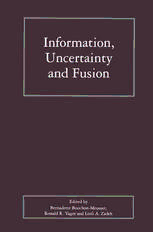Table Of ContentINFORMATION,
UNCERTAINTY AND
FUSION
THE KLUWER INTERNATIONAL SERIES
IN ENGINEERING AND COMPUTER SCIENCE
INFORMATION,
UNCERTAINTY AND
FUSION
edited by
Bernadette Bouchon-Meunier
University ofP aris
Ronald R. Yager
Iona College
and
Lotfi A.Zadeh
University ofC alifornia, Berkeley
,.
~.
SPRINGER-SCIENCE+BUSINESS MEDIA, LLC
ISBN 978-1-4613-7373-5 ISBN 978-1-4615-5209-3 (eBook)
DOI 10.1007/978-1-4615-5209-3
Library of Congress Cataloging-in-Publication Data
A CJ.P. Catalogue record for this book is available
from the Library of Congress.
Copyright © 2000 by Springer Science+Business Media New York
Originally published by Kluwer Academic Publishers in 2000
Softcover reprint of the hardcover l5t edition 2000
AII rights reserved. No part of this publication may be reproduced, stored in a
retrieval system or transmitted in any form or by any means, mechanical, photo
copying, recording, or otherwise, without the prior written permission of the
publisher, Springer-Science+Business Media., LLC.
Printed on acid-free paper.
Table ofContents
Preface ix
Information
RevisionbyTranslation 3
D.Gabbay,O.Rodrigues,A. Russo
AmbiguousImplicationsinKnowledge-BasedSystemsDescribed 33
byEntity-CharacteristicTables
S.Guiasu
FunctionalDependenciesand theDesignofRelationalDatabases 45
InvolvingImpreciseData
P.Bose,L.Li6tard
AQueryConstructforParaconsistentDatabases 57
R.Bagai
FuzzyClassifactoryObjectRecognitionforCrisisDetection 69
H.Larsen,R. R. Yager
AnApproachtoUsingDegreesofBeliefinBDIAgents 81
S.Parsons,P.Giorgini
RepresentationofComonotonicallyAdditiveFunctionalbyChoquet 93
Integral
Y. Narukawa,T. Murofushi,M. Sugeno
OnLowerandUpperApproximationofFuzzyMeasuresby 105
k-OrderAdditiveMeasures
M.Grabisch
GeneratedFuzzyQuantifiersandTheirOrderings 119
E.E. Kerce,M. Mare~, R. Mesiar
OnNeurofuzzyandFuzzyDecisionTreeApproaches 131
C.Olaru,L. Wehenkel
AFuzzyExtensiontoaTemporalParsimoniousCoveringTheory 147
S. Sandri,J.Wainer
TableofContents vi
Uncertainty 159
ProbabilitiesofFutureDecisions 161
D.Nilsson,F.V.Jensen
RepresentationsIssuesforRiskScenarios 173
S.Langley
ZeroProbabilitiesinStochasticalIndependence 185
G.Coletti,R.Scozzafava
ComputingtheProbabilityofFormulasRepresentingEvents 197
in ProductSpaces
P.A.Monney, B.Anrig
UncertaintyHandlingforDistributedDatabaseIntegration 209
and KnowledgeDiscovery
S.1.McClean,B.W.Scotney
ARule-BasedLanguageforProbabilisticReasoning 221
S.K.M.Wong
DerivingPossibilityDistributionsfromDataSetsUsingConfidence 233
IntervalsofProbabilities
L.M.deCampos,J.F. Huete
FuzzyRandomVariables-BasedModelingwithGA-PAlgorithms 245
L. Sanchez,I.Couso
ASeasonalStreamflowForecastingModel UsingNeurofuzzyNetwork 257
R. Ballini,M. Figueiredo,S.Soares,M. Andrade,F. Gomide
AllowingImprecisioninBeliefRepresentationUsingFuzzy-Valued 269
BeliefStructures
T.Denoeux
ATransformationalApproachtoFuzzyPropositions 283
F.Fernandez,J.Gutierrez
Four-ValuedLogicsfor ReasoningwithUncertaintyinPrioritizedData 293
O.Arieli
vii TableofContents
Fusion 305
AMathematicalModelforFuzzyConnectivesand itsApplication 307
toOperatorsBehaviouralStudy
E.Trillas,A. Pradera,S. Cubillo
InvariancePropertiesofOWAOperators 319
S.Ovchinnikov
AggregationOperatorsasSimilarityRelations 331
G. Beliakov
SemanticMeaningofFuzzyControlModelsandHeterogeneous 343
AggregationOperators
B.Shukhat
MaxativeFuzzyPreferenceStructures 355
B.DeBaets,1.Fodor
DirectedPossibilisticGraphsand PossibilisticLogic 365
S. Benferhat,D. Dubois,L. Garcia,H. Prade
ALogicofSupporters 381
C.Lafage,J. Lang,R. Sabbadin
BuildingArgumentationSystemsonSetConstraintLogic 393
R. Haenni,N. Lehmann
GeneticFuzzyc-MeansAlgorithmfor AutomaticGeneration 407
ofFuzzyPartitions
S.L6pez,L.Magdalena,J. Velasco
FastDempster-ShaferClusteringUsingaNeuralNetworkStructure 419
J.Schubert
DistributionofContradictiveBeliefMassesinCombination 431
ofBeliefFunctions
M. Daniel
RelationshipsAmongOrdinalRelationsonaFiniteSetofEvents 447
A. Capotorti,B.Vantaggi
Index 459
Preface
As we stand at the precipice ofthe twenty first century the ability to capture and
transmit copious amounts ofinformation is clearly a defining feature ofthe human
race. In order to increase the value of this vast supply of information we must
develop means for effectively processing it. Newly emerging disciplines such as
InformationEngineeringandSoftComputingarebeingdeveloped inordertoprovide
the tools required. Conferences suchas theInternational ConferenceonInformation
ProcessingandManagementofUncertaintyinKnowledge-basedSystems(IPMU)are
being held to provide forums in which researchers can discuss the latest
developments. The recent IPMU conference held at La Sorbonne in Paris brought
together someofthe world's leading experts in uncertainty and information fusion.
Inthis volumewehaveincludedaselectionofpapersfrom thisconference.
What should beclear from looking at this volume is the numberofdifferent
ways that are available for representing uncertain information. This variety in
representational frameworks is a manifestation ofthe different types ofuncertainty
that appear in the information available to the users. Perhaps, the representation
with the longest history is probability theory. This representation is best at
addressing the uncertainty associated with the occurrence of different values for
similarvariables. This uncertaintyisoftendescribedasrandomness. Roughsetscan
beseen as atypeofuncertainty thatcandeal effectively withlackofspecificity, itis
a powerful tool for manipulating granular information. Fuzzy sets and the related
field ofpossibilitytheory have beendeveloped toaddressanothertypeofuncertainty
that being a lack ofclarity. By extending the binary based set theory to allow for
graded membership, fuzzy sets provide a tool for the representation ofthe types of
concepts used by humans, particularly those used in describing their perceptions.
TheDempster-Shaferbelieftheory provides aframeworkparticularly well suitedfor
representing informationthatis bothrandom andgranular.
Underlying much of the processing of information is the need to fuse
information, this is especially so in attempts to implement "intelligent" operations.
x
Thefundamental processofconvertinginformationintoknowledgeis baseduponthe
fusion ofinformation. For example, a salient feature distinguishing between data
mining and data base querying is that the former generally requires the fusion of
information from multiple dataobjects while the latergenerally deals withonedata
object at time. Decision making is also an area which requires considerable useof
fusion techniques. Here information from multiplesources, satisfactionsto multiple
criteria and multiple possible outcomes must all be fused to enable decisions to be
made. Thedevelopmentofefficienttoolsforretrievalofdocuments,aconcernwhose
importance has increased in proportion to the rapid development ofthe internet,
requirestheuseoffusion techniques. Attempts toconstructintelligentagentsrequire
the use of sophisticated operations, many of which are of a fusion type, to help
model thecomplexwayshumanbeingsinteractwithinformationandeachother.
In this volume we have attempted to bring to the reader some ofthe most
recentadvancesin information, uncertainty andfusion. Indoingsowe hope tohelp
in the comingexploitationofavailableinformation.
Information

